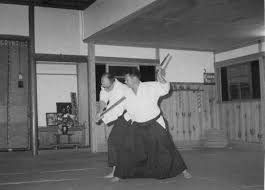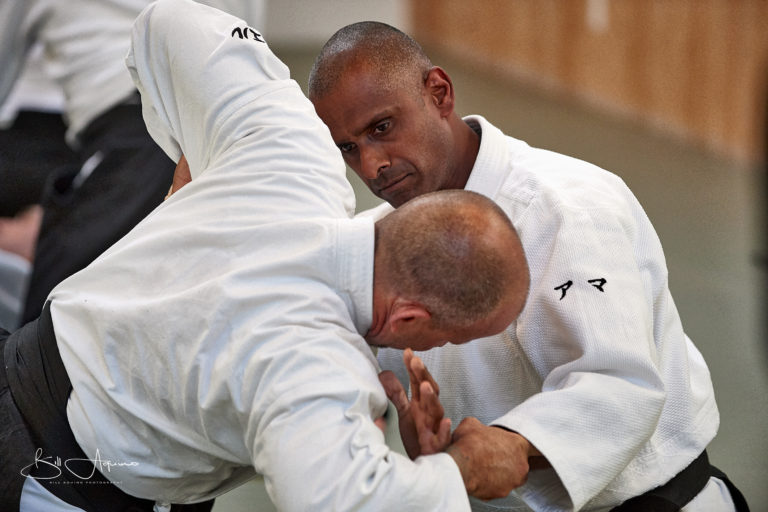 By Bill Witt Shihan, 8th-Dan Aikikai
By Bill Witt Shihan, 8th-Dan Aikikai
Originally published in the Aikido Journal.
In these days of instant gratification and learning for the sake of professional development, it is easy to lose sight of a time-honored way of receiving an education – the relationship between master and apprentice. In Europe, Asia, and in early America, the apprentice was bound to the master for a period of time, during which the master promised to teach the secrets of the trade. The apprentice usually lived with the master and became part of the family and shared in all of its joys and sorrows.
In Asia, the apprenticeship might be more open-ended. This would usually be the case when learning an art, the study of which might be life long, for personal or cultural development and not necessarily for a job skill. It might also be a bit more informal, with the master accepting a student/apprentice on an on-going basis and not bound for a set time. In this case, the apprentice literally gives himself to the master for training. This might be the case when entering into training for religious development or classical martial arts training. The bond developed between teacher and student during this time can develop into a life-long relationship, which is not easily broken.
It is unusual today, especially in the United States, for someone to say that they have a teacher and have studied with him for a long time. When people ask me about my Aikido, for instance, and I mention my teacher, and that I still consider him my teacher after 33 years, I often see raised eyebrows and a somewhat incredulous look. “It must be a cult,” they think.
I began Aikido in 1967, while O-Sensei was still alive. In fact he was the first Aikido person I ever saw, and I began Aikido because of him. How could someone resist the opportunity to learn from the founder of an art? Although I trained, in the beginning, daily at the old, wooden Tokyo dojo, I never really considered him my direct teacher. To me he was beyond that. He was The Founder. I always considered it a privilege to take a class from him and to be thrown by him. With many instructors at the dojo, I never thought of entering into a master/apprentice relationship, although others did. It was a stimulating atmosphere to be able to take classes from so many skilled Aikido practitioners-each with their own personalities and approaches. There was a change coming for me, however.
Shortly after I began, a friend in the dojo suggested that I attend the Sunday class. He felt the instructor might have an approach in which I might be interested. The first Sunday that I attended, Saito Sensei taught a class that was unusual, because it was so ordinary. I left thinking that my friend had perhaps misspoke. At that time I was training six days a week and, as a westerner, used Sunday as a day of rest. However, I decided to give the Sunday class a chance and rearranged my training schedule. From then on, I trained regularly on Sunday mornings have had a fondness for Sunday morning training ever since.
Gradually, Saito Sensei would come around during practice and give corrections. Occasionally he would even speak to me. I began to see distinctiveness in his approach and this resonated with me. It was not only the effortlessness with which he would execute techniques, but it was his patience and willingness to teach us beginners. He taught us techniques that were deceptively simple to watch, and showed us why it was important to do the technique in a specific manner time after time. At times he would stop the class and point out why a foot had to be at a particular point because the rest of the technique would not be successful otherwise. I was being initiated into the mysteries of a martial art.
One day it occurred to me that I was seeing something special. Occasionally, O-Sensei used to appear at the Sunday class and Saito Sensei was always deferential to him. He was respectful and became the student, when the Founder wished to lead the class. I was watching a master/apprentice, or what we call now a student/teacher relationship, in action. There was clearly a bond between the two men based on a long-term relationship. There also was obvious respect between them that flowed both ways.
About five months after the Founder passed away I returned to Japan and again took up training in the Tokyo dojo. Saito Sensei was still teaching the Sunday class. I was surprised that he recognized me. In class, for the last few minutes he was now teaching the jo. This was something I had never seen before in Tokyo, since the Founder had forbidden the use of weapons by students training there. One day after practice I asked Sensei, if it would be possible to go to Iwama occasionally and take instruction from him there. We agreed on a day that was convenient to him, since he worked 24 hour shifts at the railroad several days a week and was not available on those days.
I went out to Iwama alone. I arrived at the station and did not know where the dojo was. Like all first-timers since, I took a cab. It was a short ride. We went to the edge of town. The pavement ended at Onuma’s store and we were on dirt roads. The dojo looked almost the same as today. The trees, of course, were smaller. There were two lines of cherry trees at the jinja. The blooms would be a magnificent sight in the spring. However, the town had not yet grown up around it. With the dojo on the right, and the Aiki Jinja on the left, the road beyond led to open fields and pig farms. The aroma of the neighborhood was decidedly rural.
The entrance on the opposite side of the property, where the stone gate is, was the only side of the property to have houses. Hans Goto, during his stay, met a long-time resident who lived in one of the houses. He told Goto Sensei that prior to the building of the dojo by O-Sensei, no one wanted to cross the wooded property because of the ghosts. The old man told Goto that he lived on the property and tamed them down. The deshi used to swap ghost stories, and spending the night in the dojo alone was an interesting experience.
For those who have been to Iwama, next to the dojo was a run-down wooden building, now replaced by the Red Room, that was half-used for storage. The other half, at the time, was occupied by a 23-year-old deshi of O-Sensei, and now of Saito Sensei, who had the unnerving trait of looking at new students and visitors as fresh meat. There was a bell in the room, and it was his job to attend to O-Sensei, when required. Outside his door was a makiwara. He hit it 50 times, when entering and leaving his room at any time. The shokudo, the kitchen, was almost the same as today-the same furniture is still there. It did not have a shower or hot water available. There was no heat. The bath was bamboo fired and only available to use, when several people were “in residence.” The shokudo and the shower area in the dojo were built by O-Sensei’s deshi.
The Iwama dojo had a reputation in Tokyo as a tough place to train. The students trained hard and were uncompromising to newcomers, so it was said. Saito Sensei seemed to be a friendly man, however, and seemed open to having visitors. At that time the Iwama dojo was almost deserted. Because of the Founder’s passing five months before, the long-time regular students were not training. Saito Sensei was teaching regularly there and only had three students, all young 3rd dans, plus a small children’s class. There were two or three others who came to train sporadically. I arrived, I admit, with a certain naivete.
I went to Sensei’s house to announce myself. He seemed glad to see me and we went to the dojo. After explaining a few rules, we trained. I was still a first kyu at the time, hoping to take a shodan test soon in Tokyo, and the other three students were third dans. It would be easy to guess who bounced the most that day. Class was intense and enjoyable. I earned my first “dame,” a sign that the instruction had now become intensely personal. After class we went to the shokudo. Sitting around the table, Saito Sensei introduced me to the others. He introduced the live-in deshi, “This is Inagaki, 3rd dan Aikido, 8th dan fighting.” The other two students, Kawakami and Komatsusaki did not laugh at the joke. I was being measured, I thought. Later, I found out that Inagaki was working his way through college as a bodyguard.
We spent the rest of the evening getting to know each other. My Japanese, I am sure, was barely understandable, and got more so as the evening went on. Still I am glad that I took an early interest in the language. Later, I learned the three students had sensitive noses to visitors who were interested in “making a name.” Saito Sensei was bemused at their evaluation. During training, he usually tolerated a certain amount of attitude adjustment. No one was seriously hurt physically. Egos were another matter. Anyone who was there to learn and trained hard were helped by the deshi.
Later when I was considered “a regular,” I noticed that newcomers and students on gasshukus were treated with more latitude. The regular students were an inner circle and Saito Sensei was very critical during practice. Not even the smallest error in technique seemed to escape him. Several times, I am sure, he corrected my practice without seeing what I was doing.
The more I went out to Iwama, the more I wanted to stay for awhile. I still had commitments in Tokyo, but my schedule was flexible. One day a friend and I had gone to Iwama and Komatsuzaki-san asked us to help with his house-raising. We went to the site and a goodly number of local friends were there as well. The labor was quickly divided up. The men did the heavy lifting, and the ladies prepared food. Saito Sensei pitched in, as did the rest of us, under the direction of the master builder-an old man who knew every detail. We lifted beams and walls for a traditional style house. We framed the house in a day. Later as we celebrated our labors, I was struck with the similarity to American “barn raisings” of the 19th century and by everyone’s cooperation and willingness to help. From this experience came another observation. Saito Sensei was a very known and respected member of the community. I found out later that he was very active in civic affairs. One duty being to run a polling place for local elections. He was active in solving local problems and arranged quite a few marriages.
I went to Iwama more often and began to stay the night. There was evening practice, but Saito Sensei would have practice in the morning for his deshi. We would train taijutsu, and then he would ask me to go to the shokudo. He closed the doors to the main entrance of the dojo and I could hear weapons practice. Since I was just shown the basic jo katas, I was not invited to watch or take part. I had to practice kata on my own. One afternoon, he was drilling me on the jo kata. We were outside among the azaleas and, when I finished, he asked me why I wanted to come out here to train. While O-Sensei was alive, several westerners had visited Iwama so I was not the first. However, I told Saito Sensei that I wished to become his student and I wanted to train at a place that was the center of Aikido. He seemed surprised and pleased at that. He never had a foreign deshi, and Iwama, as a farm town, was quite a conservative place. I was an unusual person to his family and the neighborhood. At this time, interaction of foreigners with Japanese, especially at a rural family level, were rare. For the remainder of my stay in Japan on that trip, I visited Iwama weekly and stayed for several days at a time.
Sensei was an accomplished cook and loved to display his skill. Several generations of deshi have found his handmade soba and garlic-accentuated gyoza (pot stickers) have spoiled them for mere restaurant food. We were sitting in the shokudo, one day just after practice, and Sensei asked me what I had been doing in Tokyo. I told him that I had just been to an interesting restaurant, where I had chicken sashimi. He asked me, if I liked it, and I said I did. Without a word, he got up and left. In a few minutes he was back with holding a live rooster, a shamu, which he said was one of O-Sensei’s chickens. Within 15 minutes we had chicken sashimi. Life was certainly more basic in the country, but I really think the rooster had been crowing too early for him. He noted early on that cooking was not a talent of mine. He always joked with me that he lived to eat, and I ate to live. He had a wonderful sense of humor. It made it a pleasure to be around him.
Two years passed before I took time from my work to visit Japan again. In that time I was training in the United States and working on the jo kata practices my teacher had shown me. I wrote him asking to visit Iwama again, and was surprised when a return letter showed up quickly inviting me to come. Several years later, on a subsequent trip, Saito Sensei confided to me, when I left the first time, that he thought he would never see me again. He thought that perhaps his initial instruction in jo was muri, a wasted effort. This trip seemed to change the relationship between us. I had shown a willingness to make an effort to travel a long distance, and he noted that I had kept up my practice on my own.
I was only able to take about three weeks on this trip. When I arrived, Sensei told me that there would be a full program. The first week consisted of learning the 20 jo suburi. The second week consisted of the sword suburi and a number of sword taking techniques. I had private instruction from Sensei in the morning, noon practice on my own, and regular evening practice. Some of the senior students had started to filter back. Evening practices were better attended. I still was not allowed to see certain practices. At the end of the trip Saito Sensei had me test for nidan. I must say, he was magnanimous in his evaluation. Trying to appear skilled in about 35 just-learned techniques in two weeks was a daunting proposition for me. At the end he gave me two scrolls he had written attesting that I had received jo and sword suburi techniques. He said it was an old tradition, and was it the first time he did so.
Several years and trips passed and I received 4th dan from Saito Sensei. This time we had a long talk in the dojo. He carefully explained that I was now not a member of the dojo anymore. He wanted me to go out and find my own aikido. Of course, he continued, I was welcome at Iwama any time. I was just not a member of the dojo. In class there were no more corrections and dames. Although our relationship had changed, he was still my teacher, and I was still the student. We both understood that.
At this same time also, there was a noticeable change in Sensei. He would admonish us to train carefully and take care of newer students. This change in training came about, because of a recent death of a Japanese aikido student, during practice, in Southern Japan, which affected him greatly. He did not place limitations on deshi, when we trained with each other as peers, but his time.
One day, Sensei outlined to us how he expected us to guide and protect junior students in training. The next day a college aikido club arrived for a three day gasshuku, and I was training with the captain. This captain was being overly severe to the newer members, and I thought I would give him a taste of the same. Saito Sensei watched me for a minute and walked by saying, sotto voce, “What was I talking to you about yesterday?” He had a very high expectation of behavior of the Iwama deshi. That mild rebuke made a huge impression on me, and I smile every time I remember the lesson I learned.
Later when we met during his trips to California, we would sit and talk. Invariably we brought up those early days. He enjoyed talking of those times. The dojo was small, the practice rigorous, and the attention unrelenting. It was actually the closing of a traditional era. It is difficult, at present, to be in a dojo where the instruction is so intimate. We shared something personal with each other then, and the remembrance of it warmed us both and sustained our relationship for 33 years.
–Bill Witt



